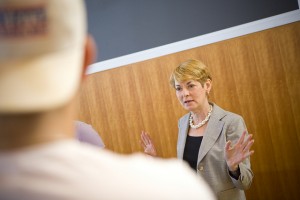When Diane Cole Ahl goes on sabbatical next academic year, don’t think she’s taking a break. Ahl, the Arthur J. ’55 and Barbara S. Rothkopf Professor of Art History, will be busier than ever.

Diane Cole Ahl, Rothkopf Professor of Art History, teaches a class in Skillman Library.
This fall, she will be the James S. Ackerman Scholar in Residence at the American Academy in Rome. Established in 1894 and supported by private, corporate, and charitable gifts as well as by grants from the National Endowment for the Arts and the National Endowment for the Humanities, the academy is a leading center for independent study and advanced research in the arts and humanities.
The only resident in the field of art history, Ahl will join impressive company, including three Pulitzer Prize winners (among them one of her favorite authors, Jhumpa Lahiri, and political cartoonist Pat Oliphant) and a winner of the international Pritzker Architecture Prize. Other residents include historians, urban planners, architects, composers, musicians, and artists.
Among her duties will be advising junior scholars who have won the Rome Prize. She’ll also attend conferences, lectures, and tours hosted by the academy as well as continue her own research. Situated at the summit of the Janiculum, one of the Seven Hills of Rome, the academy overlooks the city below and will provide Ahl with immediate and intimate access to the works she is studying. The prestigious appointment also provides access to private archives and collections closed to the public.
Ahl explains that artists from all over Europe congregated in Rome, as it was the center of the papacy and western Christianity. A city where culture, history, literature, art, architecture, and music all converge, Rome is an ideal place for Ahl to enhance her expertise in painting in the 15th century city.
“The city’s residents were avid patrons of painting and commissioned manuscripts, altarpieces, and wall paintings for chapels as well as their palaces,” she says. “Celebrations, processions, and performances were frequent occurrences, with painted decorations, parade floats, and embellished scenery. I will investigate these intensely visual phenomena and how they shaped the experience of living in the city and the creative response of painters to the visual legacy of ancient and medieval Rome that surrounded them.”
In the spring, Ahl will move on to Florence, where she has been appointed a visiting scholar at the Kunsthistorisches Institut (Art History Institute), a world-renowned research institution supported by the Max Planck Institut of Germany. This will be Ahl’s second appointment as visiting scholar; she served in this position during her previous sabbatical.
The institute, which emphasizes the connections among Italian, Mediterranean, and global visual cultures, is an ideal place for Ahl to continue her study of 15th century Florentine painting. She’ll have the opportunity to work with art historians from all over the world.
“The institute is in the center of a city that is rich in Renaissance art and architecture, where I can leave the library and, within minutes, see firsthand what I am researching,” she says.
The majority of her research lately has focused on completing The History of Fifteenth-Century Painting in Italy, to be published as part of the Yale University Press Pelican History of Art series. It will be the only book in the series on painting in 15th century Italy. She’ll join the series’ notable list of authors, including art historians from Cambridge, Columbia, Harvard, Yale, and Oxford.
Ahl, who describes the prospect of contributing a book to what is widely regarded as the authoritative art history series as “both inspiring and intimidating,” expects to finish the project in 2014 with publication set for the following year. The book analyzes paintings of all kinds, from manuscript illuminations and sacred images to paintings of mythological, historical, and erotic themes.
One of the most important themes Ahl emphasizes is the distinctive features, creativity, and richness of painting even in small towns and villages. Her approach runs counter to the trend of considering Florence the nexus of Renaissance painting. She notes that Italy was not unified as a nation until around the time of the American Civil War, so there was a rich cultural exchange between painters in Italy and other cultures, including those of Spanish, Northern European, Byzantium, and Islamic origin. She takes readers on a journey beginning in northern Italy—Venice and Lombardy—and moving south to Naples and Sicily while demonstrating the importance of France, Belgium, and Holland to shaping painting throughout the Italian peninsula.
For the last four decades, Ahl has focused her research on Italian painting and travels to Italy every summer to deepen the breadth of her understanding. She also leads the short-term study abroad course Florence: Birthplace of the Renaissance to Italy every other year with Rado Pribic, Williams Professor of Foreign Languages and Literatures and co-chair of international affairs. They took 24 Lafayette students and three adult learners to Italy this year.
“As a scholar, I am always learning through study, travel, and participating in the research communities to which I have been privileged to receive appointments,” Ahl says. “I share the great wealth of these experiences with students as well as colleagues through my teaching and writing.”
